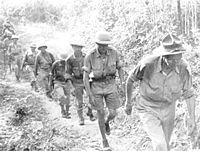Chinese Expeditionary Force
| Chinese Expeditionary Force | |
|---|---|
| Commanders | |
| Notable commanders | Sun Li-jen Du Yuming Joseph Stilwell Wei Lihuang |
The Chinese Expeditionary Force (
Background
In July 1937, the
In December 1941, the surprise
First expedition (March – August 1942)
The

The Allied forces led by the British decided to evacuate from Burma after Lashio fell to the Japanese on April 29. In response, Stilwell ordered a general retreat to India. The majority of the Fifth Army, led by Du Yuming, however attempted to retreat to Yunnan through primitive forests in Northern Burma. The units were decimated by Japanese ambush along with malaria and dysentery,[13] suffering major losses. The failure of the first expedition led to the closure of the Burma Road, and future Chinese war efforts had to rely on the Hump and the construction of the Ledo Road for logistical support.[14]
Second expedition (Early 1943 – March 1945)

Between 1942 and 1943, many Chinese soldiers were airlifted from Chongqing to India and joined the ones who had followed the British retreat there earlier, they were trained under American advisors and became the
Intending to coordinate with the X Force, Wei Lihuang's Chinese Expeditionary Force in Yunnan, known as the
Aftermath
After returning to China, the American-equipped New First Army and the New Sixth Army fought in the
References
Citations
- ^ a b Taylor 2009, p. 202.
- ^ a b c Newell 1995, p. 16.
- ^ Eastman 1986, p. 145.
- ^ Newell 1995, p. 3.
- ^ Jay Taylor, Stilwell's The Generalissimo: Chiang Kai-shek and the Struggle for Modern China, pp. 271
- ^ Eastman 1986, p. 280.
- ^ Wax 2010, p. 17.
- ^ Guyot-Réchard 2017, p. 64.
- ^ Guyot-Réchard 2017, p. 61.
- ^ Taylor 2009, p. 200.
- ^ a b Newell 1995, p. 18.
- ^ Taylor 2009, p. 203.
- ^ Taylor 2009, p. 205.
- ^ MacGarrigle 1996, p. 4.
- ^ Taylor 2009, p. 253.
- ^ Taylor 2009, p. 254.
- ^ Dunlop 2015, p. 3.
- ^ MacGarrigle 1996, p. 8.
- ^ Taylor 2009, p. 268.
- ^ MacGarrigle 1996, pp. 8–10.
- ^ Eastman 1986, p. 296.
- ^ Tatlow, Didi Kirsten (October 19, 2011). "China Honors Its War Dead, but Quietly". The New York Times. Retrieved 10 July 2017.
Bibliography
- Dunlop, Graham (2015). Military Economics, Culture and Logistics in the Burma Campaign, 1942–1945. New York: Routledge. ISBN 978-1-317-31623-7.
- Eastman, Lloyd E. (1986). The Nationalist Era in China, 1927–1949. Cambridge: Cambridge University Press. ISBN 0-521-38591-1.
- Guyot-Réchard, Bérénice (2017). Shadow States: India, China and the Himalayas, 1910–1962. Cambridge: Cambridge University Press. ISBN 978-1-316-79689-4.
- MacGarrigle, George L. (1996). Central Burma. Washington, DC: U.S. Army Center of Military History. ISBN 978-0-16-088279-1.
- Newell, C. R. (1995). Burma, 1942. Washington, DC: U.S. Army Center of Military History. ISBN 978-0-16-088260-9.
- Taylor, Jay (2009). The Generalissimo. Cambridge: Harvard University Press. ISBN 978-0-674-03338-2.
- Wax, Andrew (2010). Born in the Jungles of Burma. Newcastle upon Tyne: Cambridge Scholars Publishing. ISBN 978-1-4438-2455-2.
